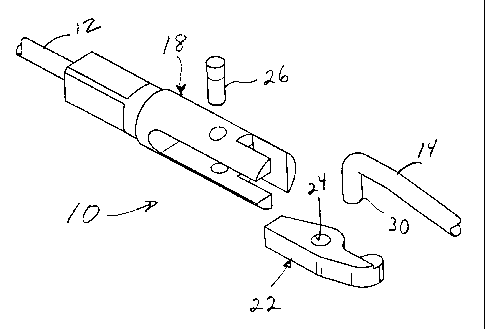Une partie des informations de ce site Web a été fournie par des sources externes. Le gouvernement du Canada n'assume aucune responsabilité concernant la précision, l'actualité ou la fiabilité des informations fournies par les sources externes. Les utilisateurs qui désirent employer cette information devraient consulter directement la source des informations. Le contenu fourni par les sources externes n'est pas assujetti aux exigences sur les langues officielles, la protection des renseignements personnels et l'accessibilité.
L'apparition de différences dans le texte et l'image des Revendications et de l'Abrégé dépend du moment auquel le document est publié. Les textes des Revendications et de l'Abrégé sont affichés :
| (12) Brevet: | (11) CA 2245300 |
|---|---|
| (54) Titre français: | ELEMENT FUSIBLE |
| (54) Titre anglais: | FUSIBLE ELEMENT |
| Statut: | Durée expirée - au-delà du délai suivant l'octroi |
| (51) Classification internationale des brevets (CIB): |
|
|---|---|
| (72) Inventeurs : |
|
| (73) Titulaires : |
|
| (71) Demandeurs : |
|
| (74) Agent: | OSLER, HOSKIN & HARCOURT LLP |
| (74) Co-agent: | |
| (45) Délivré: | 2007-05-22 |
| (22) Date de dépôt: | 1998-08-19 |
| (41) Mise à la disponibilité du public: | 1999-02-19 |
| Requête d'examen: | 2003-06-04 |
| Licence disponible: | S.O. |
| Cédé au domaine public: | S.O. |
| (25) Langue des documents déposés: | Anglais |
| Traité de coopération en matière de brevets (PCT): | Non |
|---|
| (30) Données de priorité de la demande: | ||||||
|---|---|---|---|---|---|---|
|
Un élément fusible est prévu qui comprend des parties coopérantes ajustables les unes aux autres entourées par un matériau fusible. Les parties coopérantes ajustables les unes aux autres sont disposées de manière à placer une force de compression sur le matériau fusible en réponse à une tentative de séparation des parties ajustables les unes aux autres. En outre, le dispositif permet également de réduire les forces sur le matériau fusible. En réponse à un état de temps-courant prédéterminé, le matériau fusible se ramollit suffisamment pour permettre le dégagement et la séparation des parties ajustables les unes aux autres.
A fusible element is provided that includes cooperating interfitting parts surrounded by fusible material. The cooperating interfitting parts are arranged so as to place compressive force on the fusible material in response to attempted separation of the interfitting parts. Further, the arrangement also reduces the forces on the fusible material. In response to a predetermined time-current condition, the fusible material softens sufficiently to permit the release and separation of the interfitting parts.
Note : Les revendications sont présentées dans la langue officielle dans laquelle elles ont été soumises.
Note : Les descriptions sont présentées dans la langue officielle dans laquelle elles ont été soumises.

2024-08-01 : Dans le cadre de la transition vers les Brevets de nouvelle génération (BNG), la base de données sur les brevets canadiens (BDBC) contient désormais un Historique d'événement plus détaillé, qui reproduit le Journal des événements de notre nouvelle solution interne.
Veuillez noter que les événements débutant par « Inactive : » se réfèrent à des événements qui ne sont plus utilisés dans notre nouvelle solution interne.
Pour une meilleure compréhension de l'état de la demande ou brevet qui figure sur cette page, la rubrique Mise en garde , et les descriptions de Brevet , Historique d'événement , Taxes périodiques et Historique des paiements devraient être consultées.
| Description | Date |
|---|---|
| Inactive : Périmé (brevet - nouvelle loi) | 2018-08-19 |
| Accordé par délivrance | 2007-05-22 |
| Inactive : Page couverture publiée | 2007-05-21 |
| Inactive : Taxe finale reçue | 2007-03-09 |
| Préoctroi | 2007-03-09 |
| Un avis d'acceptation est envoyé | 2007-01-29 |
| Lettre envoyée | 2007-01-29 |
| Un avis d'acceptation est envoyé | 2007-01-29 |
| Inactive : Approuvée aux fins d'acceptation (AFA) | 2007-01-16 |
| Modification reçue - modification volontaire | 2006-07-28 |
| Inactive : Dem. de l'examinateur par.30(2) Règles | 2006-05-31 |
| Inactive : CIB de MCD | 2006-03-12 |
| Inactive : CIB de MCD | 2006-03-12 |
| Inactive : CIB de MCD | 2006-03-12 |
| Modification reçue - modification volontaire | 2006-02-06 |
| Inactive : Dem. de l'examinateur par.30(2) Règles | 2005-09-30 |
| Lettre envoyée | 2003-07-07 |
| Exigences pour une requête d'examen - jugée conforme | 2003-06-04 |
| Toutes les exigences pour l'examen - jugée conforme | 2003-06-04 |
| Requête d'examen reçue | 2003-06-04 |
| Lettre envoyée | 2001-04-03 |
| Exigences de rétablissement - réputé conforme pour tous les motifs d'abandon | 2001-03-27 |
| Réputée abandonnée - omission de répondre à un avis sur les taxes pour le maintien en état | 2000-08-21 |
| Demande publiée (accessible au public) | 1999-02-19 |
| Inactive : CIB en 1re position | 1998-10-30 |
| Symbole de classement modifié | 1998-10-30 |
| Inactive : CIB attribuée | 1998-10-30 |
| Inactive : CIB attribuée | 1998-10-30 |
| Inactive : Certificat de dépôt - Sans RE (Anglais) | 1998-10-09 |
| Exigences de dépôt - jugé conforme | 1998-10-09 |
| Demande reçue - nationale ordinaire | 1998-10-07 |
| Date d'abandonnement | Raison | Date de rétablissement |
|---|---|---|
| 2000-08-21 |
Le dernier paiement a été reçu le 2006-07-18
Avis : Si le paiement en totalité n'a pas été reçu au plus tard à la date indiquée, une taxe supplémentaire peut être imposée, soit une des taxes suivantes :
Veuillez vous référer à la page web des taxes sur les brevets de l'OPIC pour voir tous les montants actuels des taxes.
Les titulaires actuels et antérieures au dossier sont affichés en ordre alphabétique.
| Titulaires actuels au dossier |
|---|
| S&C ELECTRIC COMPANY |
| Titulaires antérieures au dossier |
|---|
| GLENN R. BORCHARDT |